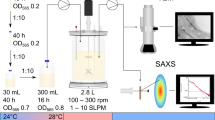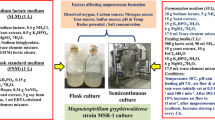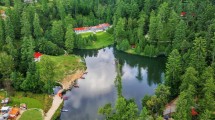Abstract
Media and growth conditions were optimized for the microaerobic cultivation of Magnetospirillum gryphiswaldense in flasks and in a fermentor, resulting in significantly increased cell and magnetosome yields, compared with earlier studies. A reliable method was established for the automatic control of low dissolved oxygen tensions (pO2) in the fermentor (oxystat). Growth and magnetosome formation by M. gryphiswaldense, M. magnetotacticum and Magnetospirillum sp. AMB-1 were studied at various oxygen concentrations. Despite differences in their growth responses with respect to oxygen, we found a clear correlation between pO2 and magnetosome formation in all three Magnetospirillum strains. Magnetite biomineralization was induced only below a threshold value of 20 mbar O2 and optimum conditions for magnetosome formation were found at a pO2 of 0.25 mbar (1 bar = 105 Pa). A maximum yield of 6.3 mg magnetite l-1 day-1 was obtained with M. gryphiswaldense grown under oxystat conditions, which is the highest magnetosome productivity reported so far for a magnetotactic bacterium. In conclusion, the presented results provide the basis for large-scale cultivation of magnetospirilla under defined conditions.




Similar content being viewed by others
References
Arras T, Schirawski J, Unden G (1998) Availability of O2 as a substrate in the cytoplasm of bacteria under aerobic and microaerobic conditions. J Bacteriol 180:2133–2136
Baeuerlein E, Schüler D, Reszka R, Päuser S (1998) Specific magnetosomes, method for the production and use. German patent PCT/DE 98/00668
Balkwill D, Maratea D, Blakemore RP (1980) Ultrastructure of a magnetotactic spirillum. J Bacteriol 141:1399–1408
Bazylinski DA (1995) Structure and function of the bacterial magnetosome. ASM News 61:337–343
Becker S, Holighaus G, Gabrielczyk T, Unden G (1996) O2 as the regulatory signal for FNR-dependent gene regulation in Escherichia coli. J Bacteriol 178:4515–4521
Blakemore RP, Maratea D, Wolfe RS (1979) Isolation and pure culture of a freshwater magnetic spirillum in chemically defined medium. J Bacteriol 140:720–729
Blakemore RP, Short KA, Bazylinski DA, Rosenblatt C, Frankel RB (1985) Microaerobic conditions are required for magnetite formation within Aquaspirillum magnetotacticum. Geomicrobiol J 4:53–72
Deshpande M, Calenoff E, Daniels L (1995) Rapid large-scale growth of Helicobacter pylori in flasks and fermentors. Appl Environ Microbiol 61:2431–2435
Grünberg K, Wawer C, Tebo BM, Schüler D (2001) A large gene cluster encoding several magnetosome proteins is conserved in different species of magnetotactic bacteria. Appl Environ Microbiol 67:4573–4582
Krieg NR, Hoffman PS (1986) Microaerophily and oxygen toxicity. Annu Rev Microbiol 40:107–130
Matsunaga T, Takeyama H (1998) Biomagnetic nanoparticle formation and application. Supramol Sci 5:391–394
Matsunaga T, Sakaguchi T, Tadokoro F (1991) Magnetite formation by a magnetic bacterium capable of growing aerobically. Appl Microbiol Biotechnol 35:651–655
Matsunaga T, Tsujimura N, Kamiya S (1996) Enhancement of magnetic particle-production by nitrate and succinate fed-batch culture of Magnetospirillum sp. AMB-1. Biotechnol Tech 10:495–500
Moskowitz BM (1995) Biomineralization of magnetic minerals. Rev Geophys 33:123–128
Sabra W, Zeng AP, Sabry S, Omar S, Deckwer WD (1999) Effect of phosphate and oxygen concentrations on alginate production and stoichiometry of metabolism of Azotobacter vinelandii under microaerobic conditions. Appl Microbiol Biotechnol 52:773–780
Safarik I, Safarikova M (2002) Magnetic nanoparticles and biosciences. Monatsh Chem 133:737–759
Sarikaya M (1999) Biomimetics: materials fabrication through biology. Proc Natl Acad Sci USA 96:14183–14185
Schleifer KH, Schüler D, Spring S, Weizenegger M, Amann R, Ludwig W, Köhler M (1991) The genus Magnetospirillum gen. nov., description of Magnetospirillum gryphiswaldense sp. nov. and transfer of Aquaspirillum magnetotacticum to Magnetospirillum magnetotacticum comb. nov. Syst Appl Microbiol 14:379–385
Schüler D (1999) Formation of magnetosomes in magnetotactic bacteria. J Mol Microbiol Biotechnol 1:79–86
Schüler D (2000) Characterization of the magnetosome membrane in Magnetospirillum gryphiswaldense. In: Baeuerlein E (ed) Biomineralization. Wiley–VCH, Weinheim, pp 109–118
Schüler D, Baeuerlein E (1996) Iron-limited growth and kinetics of iron uptake in Magnetospirillum gryphiswaldense. Arch Microbiol 166:301–307
Schüler D, Baeuerlein E (1997) Iron transport and magnetite crystal formation of the magnetic bacterium Magnetospirillum gryphiswaldense. J Phys D 7:647–650
Schüler D, Baeuerlein E (1998) Dynamics of iron uptake and Fe3O4 biomineralization during aerobic and microaerobic growth of Magnetospirillum gryphiswaldense. J Bacteriol 180:159–162
Schüler D, Frankel RB (1999) Bacterial magnetosomes: microbiology, biomineralization and biotechnological applications. Appl Microbiol Biotechnol 52:464–473
Schüler D, Köhler M (1992) The isolation of a new magnetic spirillum. Zentralbl Mikrobiol 147:150–151
Schüler D, Uhl R, Baeuerlein E (1995) A simple light-scattering method to assay magnetism in Magnetospirillum gryphiswaldense. FEMS Microbiol Lett 132:139–145
Widdel F, Bak F (1992) Gram-negative mesophilic sulfate-reducing bacteria. In: Balows A, Trüper HG, Dworkin M, Harder W, Schleifer KH (eds) The prokaryotes, 2nd edn. Springer, Berlin Heidelberg New York, pp 3352–3378
Yang CD, Takeyama H, Tanaka T, Matsunaga T (2001) Effects of growth medium composition, iron sources and atmospheric oxygen concentrations on production of luciferase–bacterial magnetic particle complex by a recombinant Magnetospirillum magneticum AMB-1. Enzyme Microb Technol 29:13–19
Acknowledgements
We thank J. Hoffmann (B. Braun Biotech International) for valuable suggestions and helpful discussions concerning the development of the oxystat. We are grateful to K. Grünberg and C. Flies for help with electron microscopy and F. Mayer (Göttingen) for providing access to the EM. The help of A. Baier and O. Menke in several growth experiments is greatly acknowledged. This work was supported by the Max-Planck-Gesellschaft, the Federal Ministry of Education and Research (BMBF), and the Deutsche Forschungsgemeinschaft.
Author information
Authors and Affiliations
Corresponding author
Rights and permissions
About this article
Cite this article
Heyen, U., Schüler, D. Growth and magnetosome formation by microaerophilic Magnetospirillum strains in an oxygen-controlled fermentor. Appl Microbiol Biotechnol 61, 536–544 (2003). https://doi.org/10.1007/s00253-002-1219-x
Received:
Revised:
Accepted:
Published:
Issue Date:
DOI: https://doi.org/10.1007/s00253-002-1219-x




